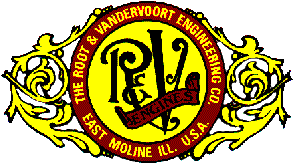
| FEATURED ENGINES | |||||

|
||||||||||||||||||
|

R & V Vertical Engines
(click here) Vertical Ignitor Patent (1903 by Orlando J. Root) To meet the growing demand for a small, reliable, medium priced motor, R&V brought out in one, two, three and one half and six horsepower sizes the upright engine. With the full realisation of the difficulties that have been experienced in the building and using of small, cheaply made engines, they studied to produce an engine for agricultural and light power purposes that would be in all respects as reliable and durable as the larger more expensive engines. Equipment: With each engine they furnish a set of Edison-Lalande type BB batteries with spark coil and switch, all in a neat box; muffler, nipples and hose for connecting engine to cooling tank, one connecting rod wrench, one monkey wrench, oil can and one gallon of gas engine oil, together with an instruction book for setting, starting and care of engine. It was in fact their intention to send out the engine complete and ready to run, with the exception of the cooling tank.
Later Vertical engines with vertical ignitor
General Description. Type of Engine: The R&V verticals operated on the standard four cycle principle and are hit-and-miss governed with make-and-break ignition. Governor: This is of the centrifugal type, a compact one arm weight attached to the flywheel giving exceptionally close regulation. The connecting rod is of I-section, a form which secures greater strength and stiffness in proportion to weight to any other. The crank end uses Copper-hardened babbitt bushings and extra long phosphor bronze bushings are used on the piston end. The wrist pin is of hardened tool-steel ground to the exact size. Crankshaft: A drop forging of liberal proportions, accurately finished to standard size and running in an enclosed dust proof crankcase. Lubrication is by the means of a splash system. Piston: This is unusually long, giving a large bearing area in the cylinder. They are machine to within a few thousandth of correct size and then machine ground to exact size. Mixer: Gasolene is maintained at a constant level in the reservoir of the mixer, with the overflow pipe taking care of any excess delivered by the pump. This assures a uniform amount of fuel to each charge, which when the needle valve is set properly, overcomes missed explosions or back firing and makes a steady running engine. Valves: Made from drop steel forgings, they are amply large with the inlet valve provided with a locking device that prevents any waste of fuel on idle strokes. This is another reason why these engines are economical in operation. The exhaust valve is water jacketed to prevent over heating. Supply tank: The 3 and 5hp models are fitted with sub-base gasolene tanks which hold sufficient fuel for 10 to 12 hours operation. The 8hp was fitted with either a sub-base tank or independent tank. Igniter, make and break: R&V use the electric spark for igniting the charge in the cylinder as it is the only mode of ignition that can be depended upon with all kinds of fuel. The igniter electrodes are of the hammer type, capped with special points that will not batter down ensuring a good bright spark. The igniter is tripped by the same rod that operates the exhaust valve. This simple feature renders the igniter inoperative when the engine is not taking an explosion, thus saving on unnecessary wear and prolongs battery life. All parts are drop forged steel except for the trip, which is very carefully tempered and hardened. Lubrication: Oil is introduced into the crank chamber by a special plug on hand hole plate. The connecting rod on its downward stroke dips into this oil which by the aid of the dasher attached to lower end of rod, not only lubricates the crank pin, but by centrifugal force of the crank distributes the oil on cylinder wall, piston and sides of crankcase. This perfectly lubricates the piston, upper end of connecting rod, gears and by aid of the two holes which collect oil from both sides of the cases, the crank shaft bearings. A lubricator for cylinder and grease cup for shaft bearings are also provided as a safeguard. Water Jackets: The cylinder head and exhaust valve are thoroughly water jacketed, preventing over heating of the engine or pitting and warping of exhaust valve. Accessories. Each Vertical Engine was furnished with a set of six (type BB) Edison-Lalande batteries with a high grade spark coil, and switch, all substantially boxed, or magneto equipment. Muffler, nipples and hose for connecting engine to cooling tank or barrel, one connecting-rod wrench, one monkey wrench and one oil can. Also an instruction book. Any
communication to owners of R&V engines can be made through Site Custodian.
|
||||||||||||||||||||||||||||||||||||||||||||